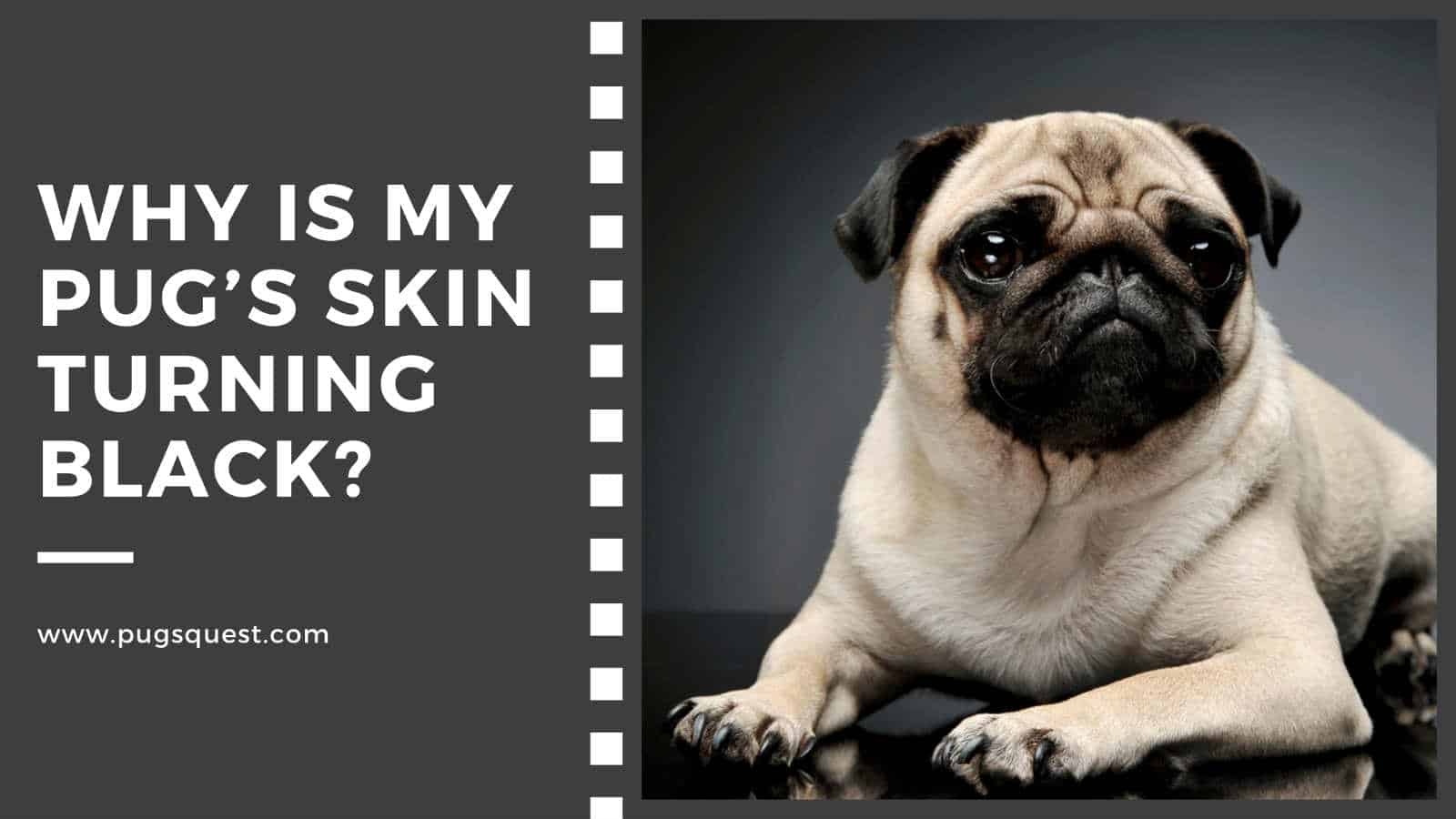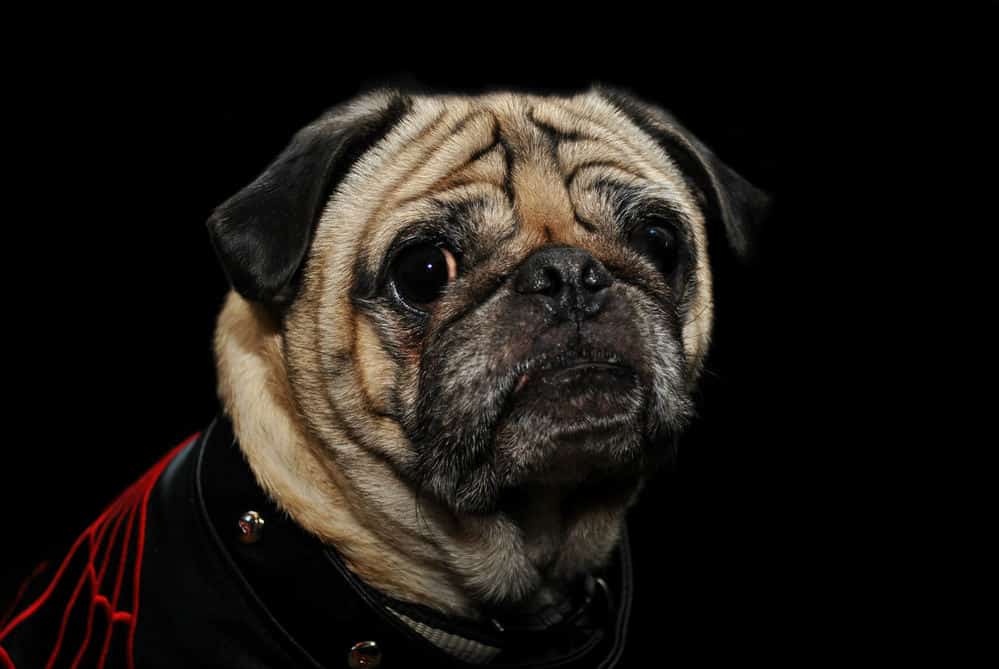
You may be wondering why my Pug’s skin turning black.
Is there anything wrong with your Pugs?
In reality, there are many possible reasons why a Pug’s skin may become discolored. From hyperpigmentation to allergies and injuries.
Let’s go to check it out.
Why Is My Pug’s Skin Turning Black?
Sometimes a Pug’s skin might start to darken. And there are many possible causes. Most often changes in skin pigmentation are the result of hyperpigmentation, old age, allergies, trauma, or even an infection.
Pugs are prone to developing skin problems and it can be difficult to identify the root cause. As such, it’s best to visit your vet for a professional diagnosis and treatment plan.
1. Hyperpigmentation
The most common reason why a Pug’s skin will darken or turn black is hyperpigmentation. Hyperpigmentation can occur in any breed of dog. It’s essentially just an overaccumulation of skin pigment. There are two main types of hyperpigmentation – primary and secondary.
- Primary hyperpigmentation
Primary hyperpigmentation is quite rare. This is a genetic skin disease. In other words, it is not triggered by any external factors. Because of this most Pugs with primary hyperpigmentation will start to show the signs and symptoms early (usually during their first year).
As yet there is no known cure for primary hyperpigmentation but the condition can be managed with medication-based treatments.
- Secondary hyperpigmentation
Secondary hyperpigmentation is far more common than primary hyperpigmentation. This is not a genetic condition and could develop at any time in your Pug’s life.
Secondary hyperpigmentation is an inflammatory condition brought on by other health issues such as skin infections, dermatitis, hormonal imbalances, and/or weight gain.
In most cases, secondary hyperpigmentation can be treated with medication. This treatment is usually quite intensive and typically takes for few months to work.
Symptoms include:
- An unpleasant odor
- Thickening of the skin
- Redness & itching
- Discharge
- Pain or discomfort
2. Aging
Sometimes changes to your Pug’s skin are just the result of aging. As your Pug gets older it’s normal for its skin to darken a bit due to years of exposure to the sun and everyday elements. This tends to be more noticeable on a fawn, silver, or brindle-coated Pug.
If your vet has ruled out any other possible medical causes, then chances are there’s nothing to worry about. Your Pug’s skin is just changing as they enter their senior years.
3. Hormonal imbalance
Hormonal imbalances can result in hyperpigmentation or darkening of the skin. If your Pug’s skin discoloration is the result of hormonal changes they will typically experience other symptoms alongside. Symptoms such as:
- Fur loss (usually in patches)
- Skin infections
- Thinning of the hair
- Thickening (or thinning) skin
- Lethargy
- Extreme thirst
- Appetite changes
In female Pugs, increased estrogen can also result in darkening of the skin. Symptoms of an estrogen imbalance include:
- Dandruff
- Changes to nipple size/shape
- Dry or brittle fur
- Itchy skin
- Blackheads
- Infection
- Inflammation
- Excess ear wax
As well as natural causes, hormonal fluctuation can be caused by some medications such as steroids. Hormonal imbalances can be diagnosed with blood tests.
4. Alopecia
Alopecia is a health condition that causes hair loss. It can occur on any part of your Pug’s body. But hair loss isn’t the only symptom. In fact, alopecia can also cause hyperpigmentation, skin darkening, and discoloration. Alopecia is quite common amongst the Pug breed.
Alopecia can be triggered by parasites, hormonal changes, and allergies. Sometimes, a Pug will develop the condition after shaving. If the fur does not grow back, the skin might darken or turn black.
Symptoms of alopecia, include:
- Hair loss
- Bald patches
- Redness & inflammation
- Lethargy
- Skin scabbing
- Scaley skin
- Itching and biting
5. Infections
Skin infections are another possible cause of hyperpigmentation. Yeast infections, bacterial infections, mange, and ringworm are all associated with darkening skin.
Pugs are prone to yeast infections due to their man skin folds. It’s important to catch yeast infections early as they can become very uncomfortable for your pet.
Symptoms of yeast infection, include:
- Greasy fur
- Lethargy
- Bad smell
- Loss of appetite
- Hair loss on back and tail
- Scratching and itching
- Bald patches
- Black freckles
If your Pug develops a yeast infection visit your vet. They will be able to prescribe antibiotics or medicated shampoos to kill the infection and get your pet back to full health.
6. Chronic licking & skin traumas
Some dogs develop a chronic licking habit – particularly if they have allergies. If they lick a particular area too much then it can cause the skin to darken.
Likewise, scarring and bruising can also cause the skin to darken. If you notice abnormal bruising on your Pug’s skin – without any known cause – then you must visit your vet. This could indicate a platelet disorder.
How Do You Treat Black Skin On Pugs?
If you start to notice the signs and symptoms of hyperpigmentation on your Pug then there are a few steps you can take.
1. Monitor your Pug’s skin
First off, make sure that you start monitoring your Pug’s skin on a regular basis.
Make a note of any changes or symptoms that you notice (this will help you if you need to visit the vet later on).
Make a conscious effort to check your Pug’s skin each day. Make it part of your routine whilst grooming, playing, or snuggling on the sofa.
2. Transition to a high-quality diet
If you start to notice your Pug’s skin darkening or turning black then start by switching their food.
Make sure that you’re giving your pet a high-quality diet full of natural ingredients and plenty of water for hydration.
You could also supplement their nutrition with some supplements. Fatty acid supplements are a great option for promoting skin health.
3. Visit your vet
If the signs of hyperpigmentation do not wane, visit your vet. They will be able to administer a full physical examination.
Although it is difficult to diagnose the root cause of hyperpigmentation in dogs, your vet is the most qualified individual to do so and will be able to prescribe the most appropriate treatment.
Black skin hyperpigmentation shares many symptoms with other diseases such as hypothyroidism and Cushing’s Disease. Because of this, the best way to make a diagnosis is through a process of elimination.
Your vet might carry out skin biopsies, blood tests, and hormone testing.
- If your Pug’s skin condition is the result of an allergy then your vet might prescribe dietary changes to reduce and manage symptoms.
- If your Pug’s skin condition is caused by infection, then your vet will prescribe antibiotics or topical treatments to treat the issue.
Hyperpigmentation itself is not easily cured. Most of the time, black skin on your Pug is nothing to worry about.
If your Pug is suffering hair loss as a result be careful to protect them from sunburn.
Primary hyperpigmentation has no known cure and will need to be managed with topical steroids and medicated shampoos.
Treating skin conditions can be a slow process, but with time and care your Pug’s symptoms should become more manageable.
Why Is My Pug’s Skin Turning Black: Last Words
If you’ve noticed your Pug’s skin turning black, don’t panic. Black skin disease doesn’t pose any real threat to your Pug’s overall health.
As we’ve discussed, there are many reasons why this might be happening and the condition can usually be managed with a healthy diet and protecting any exposed skin from the elements.
Check with your vet if you don’t solve Pug’s black skin issue. Your vet will be able to diagnose the root cause and help you manage your Pug’s symptoms.

